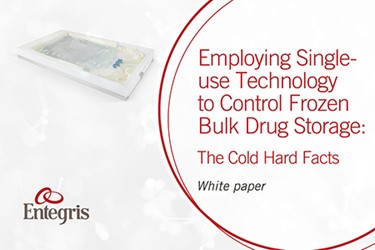Employing Single-Use Technology To Control Frozen Bulk Drug Storage: The Cold Hard Facts

New biopharmaceutical drug products that alter and even save lives can be very profitable for their developers. They are, however, costly to develop and represent significant investment, particularly at the end of the manufacturing process. For this reason, safe cost-effective frozen storage and transport are critical, especially as drugs transition from R&D through clinical trial and to higher volume production. The objectives for choosing a new storage/transport method include minimizing both capital and operating expense, reducing facility space requirements, and cutting time and energy for clean-in-place and steam-in-place processes. At the same time, valuable product must be protected from cross-batch or other sources of contamination.
The traditional approaches for primary packaging in frozen applications have been bottles and stainless steel cryo vessels. While each has its strengths, both have significant shortcomings. Bottles are bulky, nonscalable, and can slow freezing and thawing. A system of cryo vessels is costly to build and operate and adds layers of complexity in the return, cleaning, and reuse of vessels. For these reasons, manufacturers are adopting a system of single-use bags to eliminate bulk, scale as necessary, control freezing and thawing, and eliminate the need to manage container returns and reuse.
Single-use technologies have been increasingly adopted over the last 15 years to help solve critical process challenges and to robustly manufacture across an international landscape, (Figure 1).1 The advantages of implementing single-use technologies have been well documented and include among others improving manufacturing consistency across multiple sites, reducing footprint in cleanroom facilities, improving process economics/plant flexibility, and reducing clean-in-place (CIP) and steam in place (SIP) operations.
The adoption of single-use bags has challenges of its own that must be overcome to fully realize the benefits of the technology. It must have the ability to accurately scale up from low-volume production in the sub-10 L range to phase three clinical pilot and full-scale manufacturing that will exceed 300 L per batch. The materials of construction must be able to withstand the very low temperatures at which frozen drug substances are stored (-80°C or less) and must also maintain integrity through both freezing and thawing processes.
Get unlimited access to:
Enter your credentials below to log in. Not yet a member of Cell & Gene? Subscribe today.
